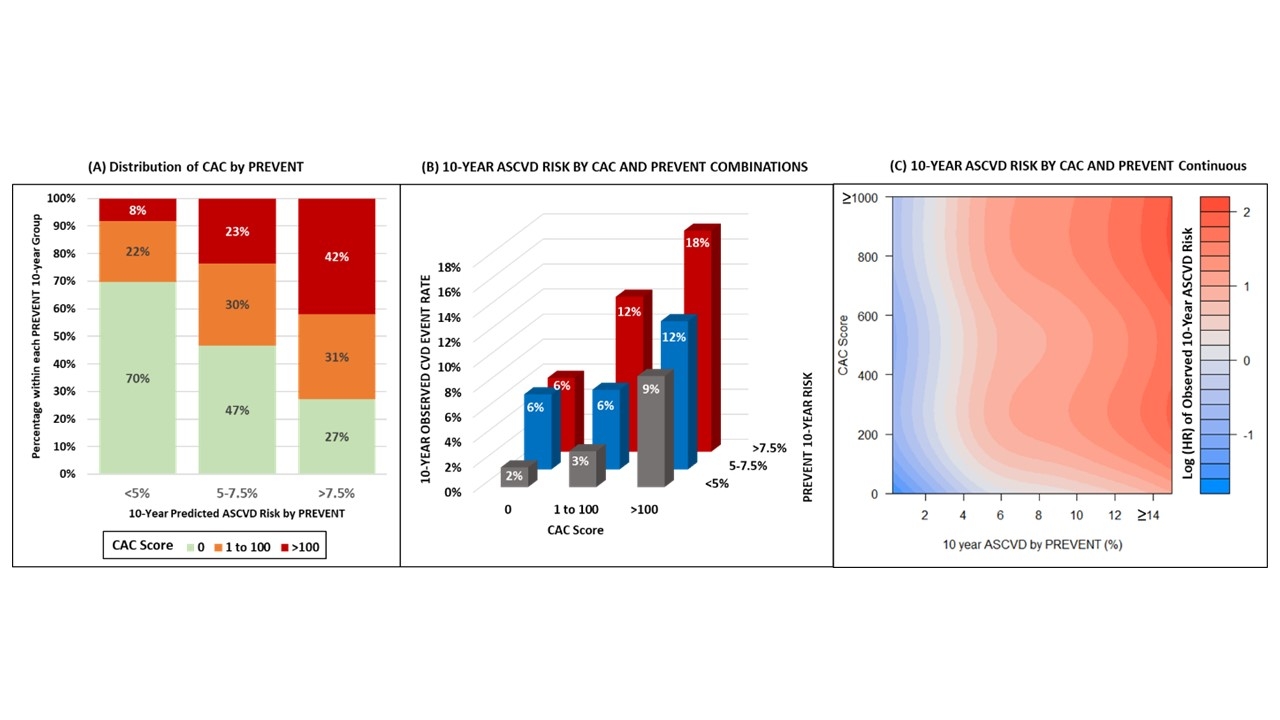Final ID: MDP1621
Interplay of Coronary Artery Calcium and Predicting Risk of cardiovascular disease EVENTs Equations in ASCVD Risk Prediction
Abstract Body (Do not enter title and authors here): Background: The American Heart Association recently introduced the Predicting Risk of CVD EVENTs (PREVENT) equations, which incorporate additional cardiometabolic risk factors to estimate atherosclerotic cardiovascular disease (ASCVD) risk in younger adults in a race-neutral manner. This study aims to assess the interplay of estimated ASCVD risk by PREVENT equations and coronary artery calcium (CAC) and their association with hard ASCVD events in a large population-based cohort.
Methods: We analyzed data from 6,380 individuals aged 45-79 years and free of ASCVD at baseline from the Multi-Ethnic Study of Atherosclerosis (obtained from the Biologic Specimen and Data Repository Information Coordinating Center [BioLINCC]). Participants were classified by baseline CAC score (0, 1–100, >100) and clinically relevant PREVENT categories (<5%, 5%–<7.5%, ≥7.5%). In unadjusted survival analysis, we evaluated the incidence and risk of hard CVD events across PREVENT and CAC scoring profiles.
Results: Among individuals with <5% risk, 70% had CAC=0 and 8% had CAC>100, whereas among individuals with ≥7.5% risk, 27% and 42% had CAC=0 and CAC>100 respectively, as shown in figure (panel A). Overall, 609 hard CVD events occurred in a median follow-up of 14.1 years (10-year observed rate of 14.3%). Individuals with <5% PREVENT score and CAC >100 had an event rate 1.5 times higher than individuals with ≥7.5% risk and CAC 0 (8.9% vs 5.9%). A CAC score of 0 was associated with 10-year CVD event rates of less than 7.5% across the estimated ASCVD risk categories (Figure, panel B). The interplay between continuous CAC and PREVENT is shown in figure (panel C)
Conclusion: Across the spectrum of PREVENT-based ASCVD risk, the distribution of CAC is heterogeneous. A high CAC burden, even among individuals with a low estimated 10-year risk by PREVENT, is associated with an elevated event rate. Conversely, the absence of CAC, even among those with elevated risk, is associated with a low event rate. CAC testing can support individual preferences in the context of shared decision making when estimating ASCVD risk and subsequent management choices.
Methods: We analyzed data from 6,380 individuals aged 45-79 years and free of ASCVD at baseline from the Multi-Ethnic Study of Atherosclerosis (obtained from the Biologic Specimen and Data Repository Information Coordinating Center [BioLINCC]). Participants were classified by baseline CAC score (0, 1–100, >100) and clinically relevant PREVENT categories (<5%, 5%–<7.5%, ≥7.5%). In unadjusted survival analysis, we evaluated the incidence and risk of hard CVD events across PREVENT and CAC scoring profiles.
Results: Among individuals with <5% risk, 70% had CAC=0 and 8% had CAC>100, whereas among individuals with ≥7.5% risk, 27% and 42% had CAC=0 and CAC>100 respectively, as shown in figure (panel A). Overall, 609 hard CVD events occurred in a median follow-up of 14.1 years (10-year observed rate of 14.3%). Individuals with <5% PREVENT score and CAC >100 had an event rate 1.5 times higher than individuals with ≥7.5% risk and CAC 0 (8.9% vs 5.9%). A CAC score of 0 was associated with 10-year CVD event rates of less than 7.5% across the estimated ASCVD risk categories (Figure, panel B). The interplay between continuous CAC and PREVENT is shown in figure (panel C)
Conclusion: Across the spectrum of PREVENT-based ASCVD risk, the distribution of CAC is heterogeneous. A high CAC burden, even among individuals with a low estimated 10-year risk by PREVENT, is associated with an elevated event rate. Conversely, the absence of CAC, even among those with elevated risk, is associated with a low event rate. CAC testing can support individual preferences in the context of shared decision making when estimating ASCVD risk and subsequent management choices.
More abstracts on this topic:
A Delayed Diagnosis of Anti-HMG-CoA Reductase Immune-Mediated Necrotizing Myopathy
Jadhav Reshma, Shekar Arush, Westenhaver Zack, Skandhan Amith
A Focus for Improvement - Factors for Lab Adherence in a Pediatric Preventive Cardiology ProgramHolsinger Hunter, Porterfield Ronna, Taylor Makenna, Dresbach Bethany, Seipel Brittany, Igwe Chukwuemeka, Alvarado Chance, Tran Andrew

